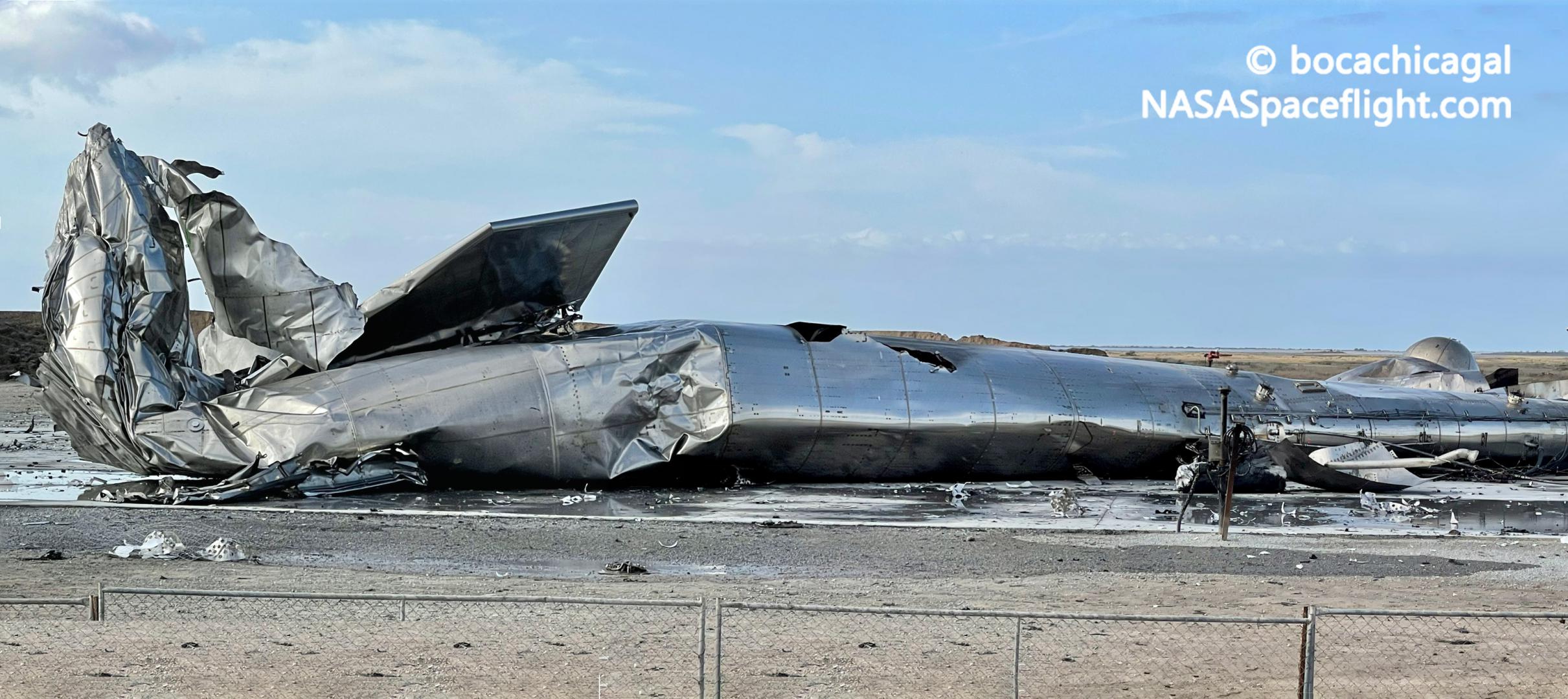
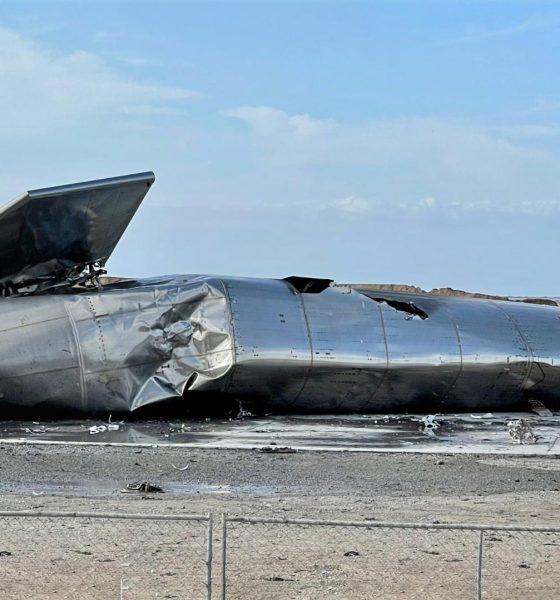
News
SpaceX already clearing Starship debris, preparing for next rocket rollout
Update: Half a day after Starship serial number 10 (SN10) became the first prototype to land in one piece, SpaceX has begun clearing its remains and preparing to roll the next rocket to the launch pad.
Never one to rest on its laurels, SpaceX appears to be wasting no time moving forward from Starship SN10’s successful landing and subsequent explosion. Almost a month ago, SpaceX stacked SN10’s successor – Starship SN11 – to its full height and has spent the last four weeks closing out the virtually identical rocket. As of SN10’s launch debut, Starship SN11 has been more or less finished and ready to roll to the launch pad for at least a week.
At the same time as SpaceX teams have begun the process of recovering SN10’s remains, the company also transported a large crane to the launch site – the same crane used to install Starships SN8, SN9, and SN10 at the launch pad. Stay tuned for updates as SpaceX prepares SN11 for a fourth high-altitude launch and landing attempt – this time with the goal of keeping the rocket intact after landing.
In a classically spectacular fashion, a SpaceX Starship prototype has successfully touched down in one piece for the first time ever, only to explode minutes later after catching itself on fire.
Rolled from SpaceX Boca Chica Starship factory to test and launch facilities just a mile down the road on January 28th, Starship SN10 lifted off just five weeks later – the fastest factory-to-launch flow yet. The speed of that turnaround was mainly made possible thanks to an exceptionally smooth test campaign, passing cryogenic proof and static fire tests after only a few attempts.
Prior to its second launch attempt, Starship SN10 automatically aborted a few seconds prior to its first attempt after the rocket’s flight computer determined that its three Raptor engines were producing more thrust than expected. Within half an hour of the abort, CEO Elon Musk took to Twitter to reveal the cause and stated that SpaceX would be tweaking the flight software’s thrust limits and recycling for another shot at launch around two hours later.
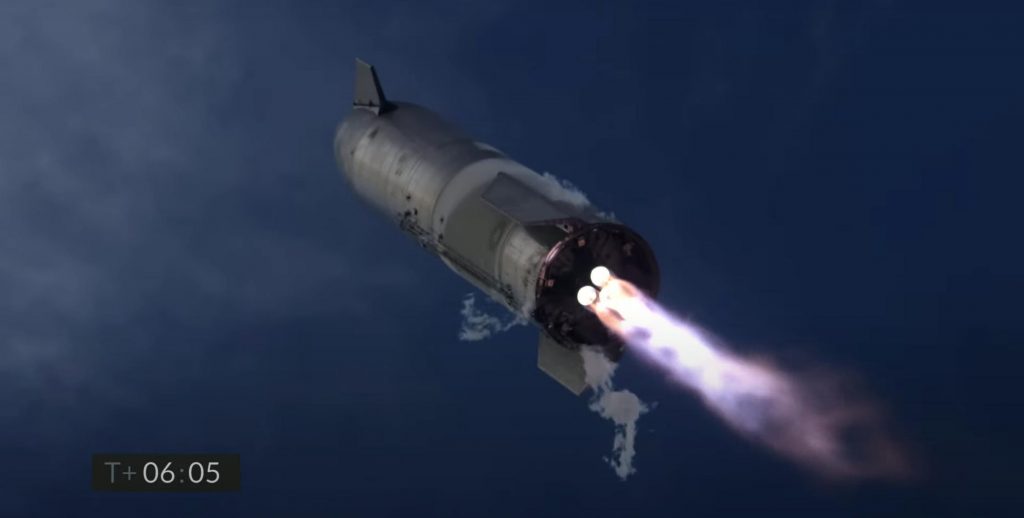

Up to the last 20 or so seconds of the 6.5-minute flight test, Starship SN10’s launch debut was virtually identical to Starships SN8 and SN9, both of which made it just one or two dozen seconds away from a soft landing. However, after SN9, SpaceX optimized the landing process to add additional redundancy, meaning that SN10 reignited all three of its Raptor engines – instead of just two – for its flip and landing burn.
Exactly as planned, SN10 fired up those engines, autonomously analyzed their performance, and then shut down two Raptors to leave the best-behaving engine to complete the final landing burn. Unlike SN8 and SN9, that maneuver went about as well as it could have, nearly slowing SN10 to a hover with one (seemingly) healthy engine to take it the rest of the way to the ground.
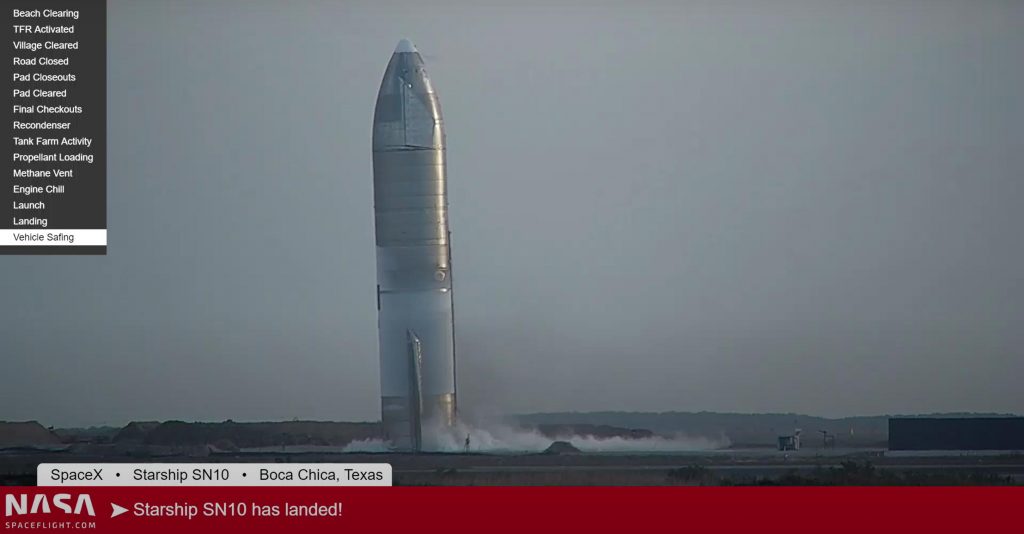

After all that heroic effort and for the first time ever, Starship SN10 proceeded to touch down in one piece. Through the eyes of a drone hovering far away from the launch complex, the landing couldn’t exactly be considered ‘soft,’ however, and SN10 impacted the landing zone with some substantial momentum – likely far too much for its tiny legs to handle.
However, more importantly, SN10 appeared to ignite one or two of its own gaseous oxygen or methane vents, triggering a fire that remained visible until well after the hard – but intact – landing. From official and unofficial views of the landed vehicle, Starship SN10 had a significant lean and appeared to have no more than a few inches to a foot of clearance between its aft skirt and the concrete pad. Remote-controlled firefighting spigots were able to extinguish any external sign of fire but that lack of clearance may have prevented the water from doing much inside the skirt, ultimately dooming Starship SN10.
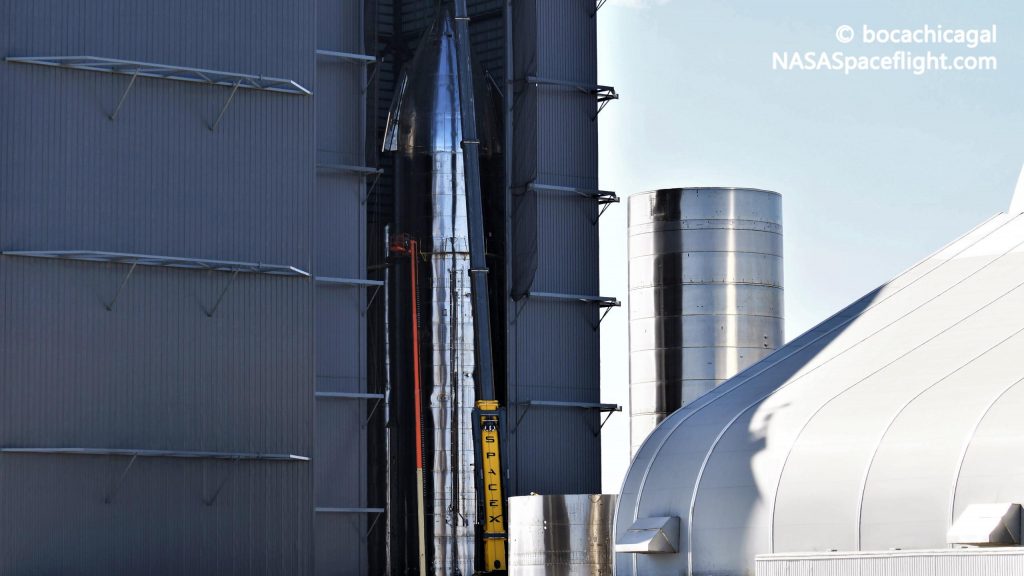
Regardless of where exactly that fire ‘broke through,’ so to speak, the original cause of the fire – accidentally igniting a vent plume – is unlikely to be a hard problem to fix, and it’s safe to say that SN10’s intact landing is an extraordinary success for SpaceX. In its official webcast, SpaceX engineer John Insprucker confirmed that Starship SN11 is all but complete and could roll out to the launch pad to pick up where SN10 left off almost as soon as it’s safe to do so.

Elon Musk
Elon Musk’s X will start using a Tesla-like software update strategy
The initiative seems designed to accelerate updates to the social media platform, while maintaining maximum transparency.

Elon Musk’s social media platform X will adopt a Tesla-esque approach to software updates for its algorithm.
The initiative seems designed to accelerate updates to the social media platform, while maintaining maximum transparency.
X’s updates to its updates
As per Musk in a post on X, the social media company will be making a new algorithm to determine what organic and advertising posts are recommended to users. These updates would then be repeated every four weeks.
“We will make the new 𝕏 algorithm, including all code used to determine what organic and advertising posts are recommended to users, open source in 7 days. This will be repeated every 4 weeks, with comprehensive developer notes, to help you understand what changed,” Musk wrote in his post.
The initiative somewhat mirrors Tesla’s over-the-air update model, where vehicle software is regularly refined and pushed to users with detailed release notes. This should allow users to better understand the details of X’s every update and foster a healthy feedback loop for the social media platform.
xAI and X
X, formerly Twitter, has been acquired by Elon Musk’s artificial intelligence startup, xAI last year. Since then, xAI has seen a rapid rise in valuation. Following the company’s the company’s upsized $20 billion Series E funding round, estimates now suggest that xAI is worth tens about $230 to $235 billion. That’s several times larger than Tesla when Elon Musk received his controversial 2018 CEO Performance Award.
As per xAI, the Series E funding round attracted a diverse group of investors, including Valor Equity Partners, Stepstone Group, Fidelity Management & Research Company, Qatar Investment Authority, MGX, and Baron Capital Group, among others. Strategic partners NVIDIA and Cisco Investments also continued support for building the world’s largest GPU clusters.
News
Tesla FSD Supervised wins MotorTrend’s Best Driver Assistance Award
The decision marks a notable reversal for the publication from prior years, with judges citing major real-world improvements that pushed Tesla’s latest FSD software ahead of every competing ADAS system.

Tesla’s Full Self-Driving (Supervised) system has been named the best driver-assistance technology on the market, earning top honors at the 2026 MotorTrend Best Tech Awards.
The decision marks a notable reversal for the publication from prior years, with judges citing major real-world improvements that pushed Tesla’s latest FSD software ahead of every competing ADAS system. And it wasn’t even close.
MotorTrend reverses course
MotorTrend awarded Tesla FSD (Supervised) its 2026 Best Tech Driver Assistance title after extensive testing of the latest v14 software. The publication acknowledged that it had previously criticized earlier versions of FSD for erratic behavior and near-miss incidents, ultimately favoring rivals such as GM’s Super Cruise in earlier evaluations.
According to MotorTrend, the newest iteration of FSD resolved many of those shortcomings. Testers said v14 showed far smoother behavior in complex urban scenarios, including unprotected left turns, traffic circles, emergency vehicles, and dense city streets. While the system still requires constant driver supervision, judges concluded that no other advanced driver-assistance system currently matches its breadth of capability.
Unlike rival systems that rely on combinations of cameras, radar, lidar, and mapped highways, Tesla’s FSD operates using a camera-only approach and is capable of driving on city streets, rural roads, and freeways. MotorTrend stated that pure utility, the ability to handle nearly all road types, ultimately separated FSD from competitors like Ford BlueCruise, GM Super Cruise, and BMW’s Highway Assistant.
High cost and high capability
MotorTrend also addressed FSD’s pricing, which remains significantly higher than rival systems. Tesla currently charges $8,000 for a one-time purchase or $99 per month for a subscription, compared with far lower upfront and subscription costs from other automakers. The publication noted that the premium is justified given FSD’s unmatched scope and continuous software evolution.
Safety remained a central focus of the evaluation. While testers reported collision-free operation over thousands of miles, they noted ongoing concerns around FSD’s configurable driving modes, including options that allow aggressive driving and speeds beyond posted limits. MotorTrend emphasized that, like all Level 2 systems, FSD still depends on a fully attentive human driver at all times.
Despite those caveats, the publication concluded that Tesla’s rapid software progress fundamentally reshaped the competitive landscape. For drivers seeking the most capable hands-on driver-assistance system available today, MotorTrend concluded Tesla FSD (Supervised) now stands alone at the top.
News
Elon Musk’s Grokipedia surges to 5.6M articles, almost 79% of English Wikipedia
The explosive growth marks a major milestone for the AI-powered online encyclopedia, which was launched by Elon Musk’s xAI just months ago.

Elon Musk’s Grokipedia has grown to an impressive 5,615,201 articles as of today, closing in on 79% of the English Wikipedia’s current total of 7,119,376 articles.
The explosive growth marks a major milestone for the AI-powered online encyclopedia, which was launched by Elon Musk’s xAI just months ago. Needless to say, it would only be a matter of time before Grokipedia exceeds English Wikipedia in sheer volume.
Grokipedia’s rapid growth
xAI’s vision for Grokipedia emphasizes neutrality, while Grok’s reasoning capabilities allow for fast drafting and fact-checking. When Elon Musk announced the initiative in late September 2025, he noted that Grokipedia would be an improvement to Wikipedia because it would be designed to avoid bias.
At the time, Musk noted that Grokipedia “is a necessary step towards the xAI goal of understanding the Universe.”
Grokipedia was launched in late October, and while xAI was careful to list it only as Version 0.1 at the time, the online encyclopedia immediately earned praise. Wikipedia co-founder Larry Sanger highlighted the project’s innovative approach, noting how it leverages AI to fill knowledge gaps and enable rapid updates. Netizens also observed how Grokipedia tends to present articles in a more objective manner compared to Wikipedia, which is edited by humans.
Elon Musk’s ambitious plans
With 5,615,201 total articles, Grokipedia has now grown to almost 79% of English Wikipedia’s article base. This is incredibly quick, though Grokipedia remains text-only for now. xAI, for its part, has now updated the online encyclopedia’s iteration to v0.2.
Elon Musk has shared bold ideas for Grokipedia, including sending a record of the entire knowledge base to space as part of xAI’s mission to preserve and expand human understanding. At some point, Musk stated that Grokipedia will be renamed to Encyclopedia Galactica, and it will be sent to the cosmos.
“When Grokipedia is good enough (long way to go), we will change the name to Encyclopedia Galactica. It will be an open source distillation of all knowledge, including audio, images and video. Join xAI to help build the sci-fi version of the Library of Alexandria!” Musk wrote, adding in a later post that “Copies will be etched in stone and sent to the Moon, Mars and beyond. This time, it will not be lost.”








